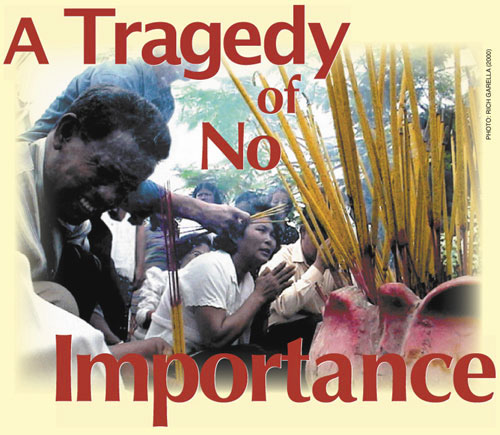by Rich Garella and Eric Pape
***
Cambodia: Hun Sen Promoting, Rewarding Killers
Human Rights Watch | 12 Nov. 2012
The 68-page report, “‘Tell Them That I Want to Kill Them’: Two Decades of Impunity in Hun Sen’s Cambodia,” documents
key cases of unsolved killings of political activists, journalists,
opposition politicians, and others by Cambodian security forces since
the 1991 Paris Agreements, which were signed by 18 countries, including
the five permanent United Nations Security Council members. The Paris
Agreements and the subsequent United Nations (UN) peacekeeping mission
were supposed to usher in a new era of democracy, human rights, and
accountability in Cambodia. More than 300 people have been killed in
politically motivated attacks since then, yet not one case has resulted
in a credible investigation and conviction.
The report’s title is a quote from Hing Bun Heang, then deputy chief of Hun Sen’s bodyguard unit,
in response to a journalist’s question about his alleged role in the
killing of at least 16 people in a coordinated grenade attack on
opposition leader Sam Rainsy in March 1997. The UN and the US Federal
Bureau of Investigation (FBI) implicated the bodyguard unit in the
attack and identified Hing Bun Heang as being in operational control. Hing Bun Heang was later promoted to the rank of lieutenant general and is now deputy commander-in-chief of the Royal Cambodian Armed Forces.
***
***
***
In remembrance of the Easter Sunday Massacre, 1997
By Theary C. Seng
I
was saved from being at the scene standing next to Sam Rainsy and Ron
Abney (the American who was injured and consequently pulled in the FBI)
because my alarm clock failed to ring; how convenient that it ran out
of battery that morning! I was awakened by a call on my borrowed hand
phone at 9 a.m. one hour after the massacre to inquire about my
whereabouts. Continue reading...
***

Must Politics Obstruct Honoring the Dead?
By Theary C. Seng
[excerpts]
On Easter Sunday morning 1997, four grenades ripped through a peaceful
group of demonstrators in front of the National Assembly, killing 20
people and wounding 100 others. The demonstrators included garment
workers, cyclo drivers, vendors, advocates of democracy, and political
activists led by Sam Rainsy, demanding independence for the judiciary.
The first memorial, a stupa, was erected on 29 March 2000, the eve of the anniversary of the grenade attacks. Two days later, this stupa was found in a sewage-outlet on the banks of the Tonle Sap.
The following day, Sam Rainsy supporters retrieved the stupa memorial from the river and returned it to its original location outside the National Assembly.
On 30 April 2000, the stupa was destroyed on location, "pounded to rubble."
The stupa was rebuilt on May 16, some two weeks later, only to be taken and dumped over the Japanese Friendship Bridge later that night at 11 p.m.
The next day, the stupa was returned and re-erected for the fourth time. In the afternoon, it was "smashed by police who raced away with debris." Later that same afternoon, yet another stupa was erected, this time with victims' ashes and a Buddha statue placed inside.
On the evening of June 12, the stupa was destroyed by a bulldozer, injuring at least three people in the chaos. The injuries prompted the involvement of then US Ambassador Kent Wiedemann and a request to the King Father.
The municipality finally awarded permission to Sam Rainsy to build a new stupa, which was officially commemorated on 3 August 2000 and remains standing to this day.
De-politicize, de-commercialize memorials – they are holy grounds
I take pain to put into detailed chronology the efforts in establishing this stupa because the persistence and energy of those who fought to build it reflect deep respect and acknowledgement of the courage and sacrifices of the lives lost. Now, this stupa is under threat of removal to Wat Botum where it will be lost in the forest of other stupas.
Remembrance is commemoration. A memorial is designed to preserve the memory of a person, a place, an event, a moment.
The removal of this memorial to a new location will remove all traces of the event from the sight of the grenade attacks, and thus defeat the purpose of remembrance and a memorial. It will diminish the symbolic meaning of "honoring" those who died in the grenade attacks.
The stupa is not a war memorial; it should not be a political issue. The deceased were high school students, garment workers – simple ordinary citizens, not politicians – exercising their right to demand greater justice and democracy. Yes, the peaceful gatherers were led by Sam Rainsy, but their memories should not be politicized. Moreover, the place of the tragedy is sacred ground and should be treated as such in its remembrance.
The degree to which we value and treasure life is reflected in the way we remember our loved ones.
***



Scam Rainsy kept accusing Mr. Hun Sen to be behind the 1997 grenade attack. Mr. Hun Sen threatened to sue Scam Rainsy, then Scam Rainsy threatened to counter-sue.
ReplyDeleteI have asked a simple question, "Many supporters of Scam Rainsy died, but Scam Rainsy did not sue. But he would sue if Mr. Hun Sen sued. So, were the lives of those dead supporters were not enough for Scam Rainsy, but it was only because he was being sued?"
That's what you got for a leader and clearly he is vain, a loser actually.
2:28 AM
DeleteWe all know who you are, and what you're trying to do.
You're a senile Yuon miserable troll.
Got it ? Get it ? Good !!!